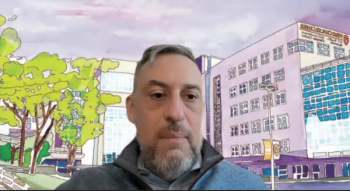
- November 2025
- Volume 31
- Issue 12
- Pages: SP865
Striking a Balance: Innovation, Affordability, and Equitable Access in Cancer Care
Key Takeaways
- Academic-community oncology collaboration is crucial for scaling innovation and managing costs, with communication as a key component.
- Value-based care and early palliative care are strategies to mitigate rising cancer treatment costs due to longer patient survival.
Experts discuss the intersection of innovation, affordability, and access in cancer care, focusing on multiple myeloma and NSCLC advancements.
The convergence of innovation, accessibility, and cost-effectiveness took center stage at the Institute for Value-Based Medicine® regional event “Driving the Future of Cancer Care: Denver,” held October 2, 2025, in Colorado. Presented by The American Journal of Managed Care®, the evening featured oncologists and other clinical experts discussing critical issues across the cancer care spectrum, from academic-community collaboration to the precision medicine revolution in non–small cell lung cancer (NSCLC) and the evolving financial landscape of multiple myeloma treatment.
Discussions highlighted ongoing efforts to strike a balance between cutting-edge science and the practical realities of patient care, cost, and access.
Scaling Innovation Through Collaboration and Value
The event began with a focused discussion on the critical relationship between academic and community oncology, a partnership that is essential for scaling innovation and value in cancer care. Moderated by Dana Weber, MSN, RN, senior manager of Transformation and Quality at The US Oncology Network, the panel explored how these worlds must align to improve patient outcomes and manage costs.
Panelists Glenn Balasky, executive director at Rocky Mountain Cancer Centers (RMCC); Theresa Medina, MD, an associate professor at the University of Colorado Anschutz Medical Campus; and Eiko Browning, MD, an oncologist/hematologist at RMCC, provided operational and clinical perspectives.
Browning highlighted the complementary nature of the collaboration, noting that community oncology is well-suited to deliver the standard of care and services “close to home” for patients, but that certain elements are better suited for academic centers.
“We do have clinical trials, and we do have physicians who are very involved in clinical trials, but not all of us are necessarily clinical trial specialists or have the largest portfolio,” Browning said. “Clinical trial treatments, and some of the higher toxicity treatments are probably best done at the University of Colorado.” She added that treatments involving complex multidisciplinary care may also be better suited for the academic setting. Although plenty of multidisciplinary work is done in the community, including hours of tumor boards each week at RMCC, it may be done less frequently in real time for patients than at an academic center where the multidisciplinary care team is physically present.
Medina emphasized that communication is the bedrock of this relationship. Collaboration can help patients receive treatment in the academic setting for initial visits or when they need highly toxic therapies, but they can continue their care in the community setting. From an administrative standpoint, Balasky underscored the importance of maintaining operational bridges between the community and academic settings.
“In my view, my key role is maintaining those relationships and keeping those doors open, even if that door closes for a while,” he said. “We’ve had relationships where the door is closed for a while but has opened again. Always be open to that, as far as working together with the community fabric.” He noted RMCC’s commitment to collaboration with University of Colorado Health and to ensuring that subspecialty care at RMCC is on “equal footing” with university programs, allowing patients to receive high-level care while maintaining access.
The conversation shifted to value-based care and the rising cost of cancer treatments, which have become the top driver of health care costs for many employers.1 Balasky explained that this increase is not due to inefficiency, but because patients with cancer are living longer. Although this is a positive outcome, it means patients are being treated for more extended periods, leading to higher costs over time. Successfully implementing value-based care is one way that practices are working to mitigate costs, he said.
Browning emphasized the value of early palliative care for better symptom management and discussions around goals of care. Palliative care nurse practitioners can spend longer with patients than oncologists and can take valuable notes for other providers to review. Early, comprehensive palliative care can also help mitigate acute illnesses requiring high-cost hospitalizations, she noted.
The discussion also touched on the technical hurdle of interoperability, where technical standards exist for clean data transfer, but proprietary systems and HIPAA regulations can challenge seamless collaboration.
“I envision artificial intelligence playing a role in this, too, being able to synthesize a lot of the data and make it a little bit easier for us to just get the highlights from that,” Medina said.
Balancing Innovation and Affordability in Multiple Myeloma
A panel discussion moderated by John M. Burke, MD, associate chair of the Hematology Research Program at RMCC, addressed the rapid pace of therapeutic advances in blood cancers. The panelists—Dan Sherbenou, MD, PhD, an associate professor of medicine in the Division of Hematology at the University of Colorado Anschutz Medical Campus; Gregory Britt, MD, a hematologist/oncologist at RMCC; and Kate Mimken, BSN, RN, FNP-C, a nurse practitioner at Colorado Blood Cancer Institute—delved into the latest developments, including the use of CD38-targeting antibodies in smoldering myeloma.
Sherbenou explained that, historically, smoldering myeloma was a condition that most clinicians were comfortable actively monitoring and spacing out visits according to risk, but that the phase 3 AQUILA trial (NCT03301220) showed potential in single-agent daratumumab (Darzalex; Johnson & Johnson) for high-risk patients.2 Burke noted that the FDA Oncologic Drugs Advisory Committee voted in favor of the treatment, given the risk-benefit profile,3 but the question of value doesn’t have a clear answer. Mimken emphasized the importance of individualizing treatment and having open conversations with patients, even if a drug is broadly available.
Britt discussed the emerging role of treating smoldering myeloma to potentially delay progression to symptomatic, active disease. He highlighted the benefit of new therapies for select populations.
“I think that in certain patients, [treatment is] attractive. If you have an [older] patient who you get the sense wants to avoid combination chemotherapy for symptomatic, active myeloma, it’s a nice way to hopefully delay that,” Britt said. But in younger patients who will likely need combination therapy and transplant eventually, it might make sense to hold off on single-agent therapy in the smoldering setting, he added.
The panel also discussed the move to subcutaneous formulations of monoclonal antibodies, which Britt said can save chair time for patients and potentially costs due to the delivery method.
“If we’re talking about value, I think economic and value to the patients and quality of life should be first and foremost if we have an equally effective drug,” Mimken said. “As far as daratumumab vs isatuximab [Sarclisa; Sanofi], as of right now, we use more daratumumab just because of the subcutaneous [delivery method]. But isatuximab is equally effective, and I think once that becomes subcutaneous, it certainly will be maybe not equal, but up there with use.”
Minimal residual disease (MRD) testing was the final topic of the session, with panelists pointing out the potential for value and cost savings by safely stopping therapy for patients who achieve a deep, MRD-negative remission.
“I think the summary here is that MRD testing offers a lot of potential to really assess the depth of remission and tailor therapy [or] reduce therapy based on that,” Burke said. “So that, for sure, is going to be future myeloma practice. I think everyone agrees on that.”
Value-Driven Precision in NSCLC and Achieving Equitable Access
Strategies to expand equitable access to biomarker testing for NSCLC and the evolving role of perioperative immunotherapy were highlighted in another session moderated by Evan Slater, PharmD, director of pharmacy at RMCC.
Panelists Lida Bighash, PharmD, BCOP, an oncology clinical pharmacist in the hematology-oncology department at Denver Health; Rao Mushtaq, MD, an oncologist/hematologist at National Jewish Health; and Michael McLaughlin, MD, a medical oncologist and associate division chief of oncology at Denver Health, analyzed the clinical and logistical challenges of implementing precision medicine.
Tissue biomarker testing has become the first line in NSCLC, McLaughlin said, noting that with lung cancer, getting targeted questions answered up front is key for therapy planning. Down the line, he sees liquid biopsy becoming the first-line standard. Bighash also stressed the urgency of early testing.
“Molecular testing is essential for almost all [patients with][ non–small cell lung cancer,” Bighash said. “[Testing] up front and early is essential because if we are not getting those tests ordered immediately, there’s going to be a delay—not only in the molecular testing results, but after that, in being able to obtain the desired treatments for the patient.”
The panel also agreed that there are major barriers to timely testing. The most substantial barriers are tissue biopsy turnaround time and insurance approval issues for tissue biopsy, Mushtaq said. Liquid biopsy, on the other hand, is usually covered, he said. Bighash added prior authorization to the list of steps that can cause delays.
When patients are uninsured, Bighash noted the importance of collaborative relationships with companies who can provide comprehensive molecular testing for free or for nominal fees.
With the advent of immunotherapy, which has been a game changer for patients with certain mutations, biomarker testing has become more important than ever, the panelists agreed.
Access in Rural Settings and Interoperability
The discussion extended to the challenges of equitable access in rural settings and the role of data-sharing technology. Mabel Mardones, MD, a medical oncologist at RMCC, joined panelists Wells Messersmith, MD, chief medical officer for oncology services at UC Health and division head for medical oncology at the University of Colorado Cancer Center; Marcus Garcia, managed care director at RMCC; and Nauman Moazzam, MD, hematologist/oncologist at RMCC.
Data sharing technology is a crucial aspect of cancer care coordination. But although there have been advances, there is a long way to go before system interoperability is seamless, the panelists agreed.
Moazzam emphasized the utility of technology in oncology practice. “I think since COVID-19, I attend 11 tumor boards a month, and everything is virtual,” he explained, highlighting the new efficiency in tumor board participation.
He added, “I think the patient gets better care, quicker care, quicker answers, and especially in the rural setting, if we can expand the virtual tumor boards to our colleagues down in other parts of the state where they don’t have that access. I am a strong believer in tumor boards and think it improves the quality of care.”
Messersmith noted the importance of facilitating multidisciplinary care for rural patients by scheduling visits in a way that requires minimal travel. Having patients spend a half day visiting multiple specialists can ensure that they leave with a comprehensive treatment plan, even if the care is delivered in the community setting.
Clinical trial participation can also be made more feasible for rural patients if trials are decentralized, a concept that has been widely discussed but not yet implemented in clinical practice. “I haven’t seen the type of change that I thought I was going to see, given everything that was published and talked about,” Messersmith said.
In closing, Garcia discussed the need for administrative reform to reduce friction in the system, particularly concerning payers.
“It’s really the working closer with the payers, because they have their own labs and things that they wanted us to use, and trying to push through the barriers on that side of it is where we run into issues with that, the prior authorization attached to that, as well,” Garcia said. Overcoming bureaucratic challenges is a must to mitigate barriers and simplify care for patients, he said.
References
1. 2026 Employer Health Care Strategy Survey: executive summary. Business Group on Health. August 19, 2025. Accessed November 1, 2025. https://www.businessgrouphealth.org/resources/2026-employer-health-care-strategy-survey-executive-summary
2. Dimopoulos MA, Voorhees PM, Schjesvold F, et al; AQUILA Investigators. Daratumumab or active monitoring for high-risk smoldering multiple myeloma. N Engl J Med. 2025;392(18):1777-1788. doi:10.1056/NEJMoa2409029
3. U.S. FDA Oncologic Drugs Advisory Committee votes in favor of the benefit-risk profile of Darzalex Faspro (daratumumab and hyaluronidase-fihj) for high-risk smoldering multiple myeloma. News release. Johnson & Johnson. May 20, 2025. Accessed November 1, 2025. https://www.jnj.com/media-center/press-releases/u-s-fda-oncologic-drugs-advisory-committee-votes-in-favor-of-the-benefit-risk-profile-of-darzalex-faspro-daratumumab-and-hyaluronidase-fihj-for-high-risk-smoldering-multiple-myeloma
Articles in this issue
about 1 month ago
The Power of a Unified Voiceabout 1 month ago
What Patients Are Really Telling Us About the Use of AIabout 1 month ago
A Prescription for Improving Biomarker Testing for More Patientsabout 2 months ago
Team-Based Precision Oncology: Advancing Value and Access in Cancer CareNewsletter
Stay ahead of policy, cost, and value—subscribe to AJMC for expert insights at the intersection of clinical care and health economics.







































